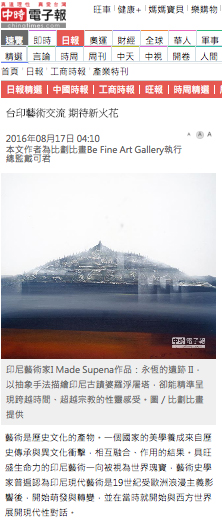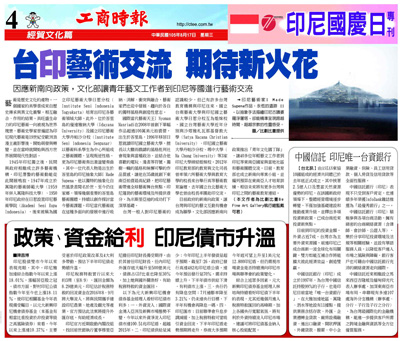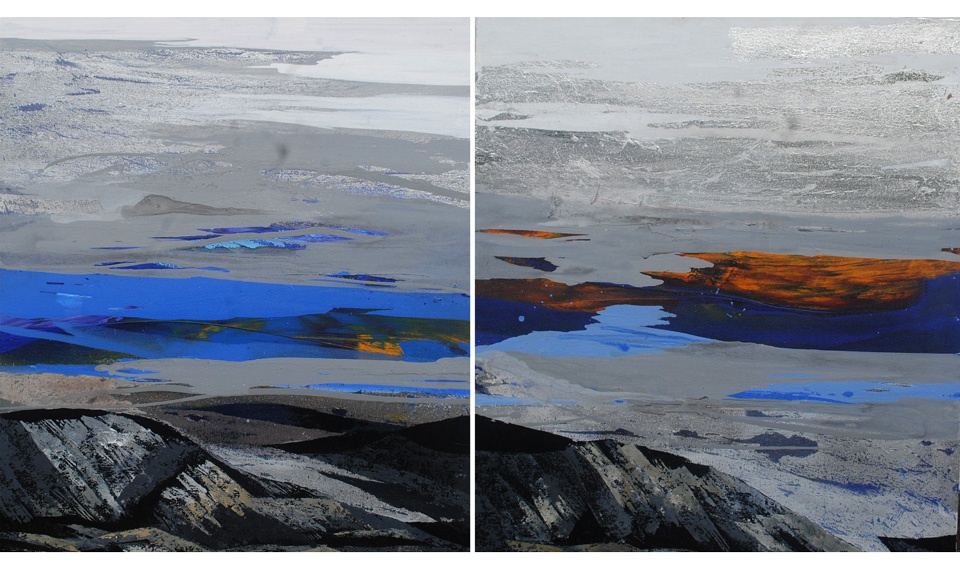I Made Supena
To celebrate Indonesian National Day, Be Fine Art Gallery invited to introduce Indonesian art to Taiwan
released on Commercial Times and Chinatimes.comArtist: I Made Supena
As we all know, art manifests the evolution of history and culture. Aesthetic cultivation of a country is derived from the results of interfusion and interaction between its historical heritage and foreign-cultural impact. The vigorous Indonesian art has been regarded as treasure of the world, and art historians generally believe that modern Indonesian art has started its development and mutation after the impact made by European romanticism in the 19th century, simultaneously carrying out modernity dialogues with the western world.
 With the independence of Indonesia in 1945, numerous art institutions have been established in succession by government and private sector, resulting in emerging development of the hidden artistic motion in Indonesia, in which educational institutions particularly possess the most powerful influence. Masters in various Indonesian art domains have been fostered by the Art Normal University of Bandung established in 1947 (integrated into Bandung Institute of Technology, ITB in 1959), and the Indonesian Academy of Fine Arts (Akademi Seni Rupa Indonesia, ASRI) founded by Indonesia government in Yogyakarta in 1950, later known as Institute Seni Indonesia Yogyakarta (ISI Yogyakarta). Moreover, the rebelling individuality emerged from art communities comprising primarily students of art departments from Udayana University (UNUD) located in Bali and Institute Seni Indonesia Denpasar (ISI Denpasar) also played surging variations for Indonesian art. One of the iconic figures is I Made Supena, the Indonesian abstract art master born in 1970 in Bali. Supena has been renowned worldwide for his unique abstractized nature landscape paintings, whereas he lives in hometown, leading several major art communities in Bali to keep exploring today’s art subjects through efforts in his creation. It is the process of multi-dimensional development in which contemporary Indonesian art has been undertaking absorption, dispersion, conflict and fusion, thereby artists transform toward individually unique styles and their creative wills.Among these, the worldwide chief in contemporary art, I Nyoman Masriadi is a mention-worthy example. The super star in art circle who created a record in 2008 for a single work exceeding one million US dollar of hammer price in an auction, was born in Bali in 1973. He moved to Yogyakarta in 1996 to study in Institute Seni Indonesia, he is good at criticizing social phenomenon and power-holding politics with his audacious and bantering manners, consolidating with his favorite global symbols such as computer games and comics. With his distinctive style and the invulnerable texture in the works, resembling a dark horse, Marsriadi had created the highest-price record in Southeast Asia auctions early at his young age of 35, bringing Indonesian art in the spotlight of global art stage. There might be several underlying factors resulting in Marsriadi’s success, but the vigorous art circumstance in Indonesia and the advantages it offered undeniably built a sound foundation for him.
With the independence of Indonesia in 1945, numerous art institutions have been established in succession by government and private sector, resulting in emerging development of the hidden artistic motion in Indonesia, in which educational institutions particularly possess the most powerful influence. Masters in various Indonesian art domains have been fostered by the Art Normal University of Bandung established in 1947 (integrated into Bandung Institute of Technology, ITB in 1959), and the Indonesian Academy of Fine Arts (Akademi Seni Rupa Indonesia, ASRI) founded by Indonesia government in Yogyakarta in 1950, later known as Institute Seni Indonesia Yogyakarta (ISI Yogyakarta). Moreover, the rebelling individuality emerged from art communities comprising primarily students of art departments from Udayana University (UNUD) located in Bali and Institute Seni Indonesia Denpasar (ISI Denpasar) also played surging variations for Indonesian art. One of the iconic figures is I Made Supena, the Indonesian abstract art master born in 1970 in Bali. Supena has been renowned worldwide for his unique abstractized nature landscape paintings, whereas he lives in hometown, leading several major art communities in Bali to keep exploring today’s art subjects through efforts in his creation. It is the process of multi-dimensional development in which contemporary Indonesian art has been undertaking absorption, dispersion, conflict and fusion, thereby artists transform toward individually unique styles and their creative wills.Among these, the worldwide chief in contemporary art, I Nyoman Masriadi is a mention-worthy example. The super star in art circle who created a record in 2008 for a single work exceeding one million US dollar of hammer price in an auction, was born in Bali in 1973. He moved to Yogyakarta in 1996 to study in Institute Seni Indonesia, he is good at criticizing social phenomenon and power-holding politics with his audacious and bantering manners, consolidating with his favorite global symbols such as computer games and comics. With his distinctive style and the invulnerable texture in the works, resembling a dark horse, Marsriadi had created the highest-price record in Southeast Asia auctions early at his young age of 35, bringing Indonesian art in the spotlight of global art stage. There might be several underlying factors resulting in Marsriadi’s success, but the vigorous art circumstance in Indonesia and the advantages it offered undeniably built a sound foundation for him.

In Taiwan, general public seldom know much about Indonesian art, but in fact, there have been exchanges among several educational institutions from Taiwan and Indonesia. Tainan National University of the Arts and Institute Seni Indonesia Yogyakarta are sister schools for each other, National Taiwan University of Arts lately also has forged alliances as sister schools with three universities in Indonesia, including Satya Wacana Christian University, Institute Seni Indonesia Denpasar, and Ma Chung University. Furthermore, in 2012, a delegation comprising presidents from six art universities and education universities led by Director General, Bureau of Education and Cultural, Ministry of Education, Indonesia has participated in the Taiwan‐Indonesia Higher Education Summit. In 2015, a delegation from Taipei National University of the Arts led by its president also visited Indonesia for exchanges.
In addition, the 2016 New South-Forward Policy from new government further enables art and cultural interaction between Taiwan and Indonesia to possibly become a prominent issue. To respond accordingly to the New South-Forward Policy, Ministry of Culture takes the lead to launch the “Young Cultural Gardeners Squadron”, allowing more than 40 young literary and art workers to visit local communities in Southeast Asia countries such as Indonesia for exchanges with art groups. Moreover, a New South-Forward Project Team has lately been established by Ministry of Education, organizing a budget to focus on the investment for Southeast Asia talents training, hopefully there will be more activities in the future for art and educational linkage between Taiwan and Indonesia.
(Written by Nicole Dai, Executive Director for Be Fine Art Gallery)

